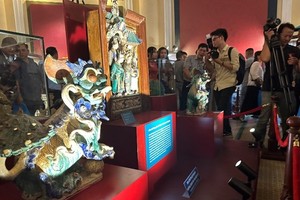The Complex of Hue Monuments is recognized as a UNESCO World Cultural Heritage Site in 1993. The recognition gave Thua Thien-Hue province a chance to widen cultural exchange with countries throughout the world, said Director of the Hue Monuments Conservation Center, Phan Thanh Hai.

It has also created condition for artists, researchers, scientists and artisans to develop their creativity, launch tourism products to attract more visitors and promoting the social economy of the province and neighboring areas as well as calling on the assistance of international community for restoration and preservation of Hue heritages.
The architectural complex of Hue is located along the banks of the Huong River in the province of Thua Thien – Hue. The city of Hue is the center of culture, politics, the economy of the province; it was the ancient capital of Vietnam feudal Nguyen Dynasty from 1802 to 1945.
Hue heritages, including the Complex of Hue Monuments, Nha Nhac – Vietnamese court music, the woodblocks of the Nguyen Dynasty, the royal documents of the Nguyen Dynasty, and the royal literature on Hue royal architecture received UNESCO's recognition.
“Hue: One destination – Five heritages” has become a tourism slogan of the province.
Hue ancient city is one of the most popular Vietnam destinations. The Hue ancient capital complex became the first in Vietnam to be recognized as a world cultural heritage by UNESCO in 1993. Since then, Hue city has made all efforts to preserve the heritage’s values and been appraised as a good example of heritage conservation.
General Director of UNESCO Irina Bokova has highly appreciated the efficiency as well as the efforts and commitments of Thua Thien-Hue in the protection, preservation and promotion of cultural heritage sites. She affirmed UNESCO’s continued assistance to the province in protecting its heritages, dealing with climate change, sharing experience from sustainable development, and in persuading local people’s larger participation in preserving and promoting cultural values of the locality’s heritages.
The Complex of Hue Monuments site has suffered from the effects of wars, as well as modern development and expanding human settlements.
According to director of the Hue Relic Conservation Center, Phan Thanh Hai, about VND585 billion was spent on restoring 100 architectural buildings in the 2010-2015 periods. The funding came from State and provincial budgets and international assistance.
The Complex of Hue Monuments welcomed the 2.5 millionth tourist in 2016. Ticket proceeds in 2016 are expected to total more than 260 billion VND (11.4 million USD).
The local authorities have continued to call for fund coming from State and provincial budgets and international assistance to launch new tourism products. The center will open to visitors at night, from 6:30pm to 10pm every day, aiming at offering visitors more time to explore Hue heritages.
























